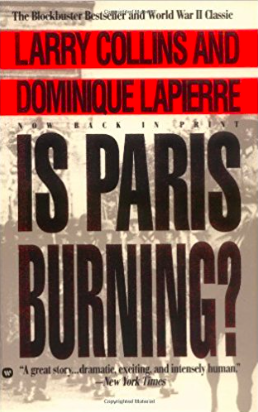
![]() Published right about the same time my family moved to Europe, Collins and Lapierre’s book is a classic on World War II and specifically, the events of liberation as they unfolded in Paris during August 1944. The title is reportedly the question Hitler asked of his Commander of Greater Paris, General Dietrich von Choltitz. Upon appointing von Choltitz as the military governor on 9 August 1944, Hitler gave his general the instructions—known as the “Nero Decree”—to level Paris.
Published right about the same time my family moved to Europe, Collins and Lapierre’s book is a classic on World War II and specifically, the events of liberation as they unfolded in Paris during August 1944. The title is reportedly the question Hitler asked of his Commander of Greater Paris, General Dietrich von Choltitz. Upon appointing von Choltitz as the military governor on 9 August 1944, Hitler gave his general the instructions—known as the “Nero Decree”—to level Paris.
The writers created a fast moving and absorbing story with multiple plot lines. It’s no wonder the book became a popular movie. The book begins with the city when “this warm August morning marked the 1,503rd day of its German occupation.” On or about 12 August 1944, events were triggered that resulted in the liberation of Paris thirteen days later. The domino effect of the events quickly set off the frenzy of the Resistance, diplomatic efforts by the Swedish consulate to save the city, and feverish requests to Eisenhower by the Free French Forces under General de Gaulle for Allied troops (including French troops) to enter the city.
The Germans entered the city on 14 June 1940 with orders to behave themselves and treat the Parisians with respect. By mid-1942, this façade had disappeared as the Nazis stepped up their occupation by terror. Immediately after the success of D-Day and as the Allies began to advance away from the beaches, the Germans in Paris knew it was only a matter of time before Eisenhower would reach the city. While the Germans left a trail of atrocities across the occupied countries, they were the most dangerous during the latter part of the war when it became clear they were going to lose war and the retreating soldiers began to try and cover up their dastardly deeds.
The second part of the book focuses on “The Struggle” during the two weeks leading up to the liberation. The cast of characters is sometimes hard to keep up with but that’s not the fault of the authors. There were so many competing players and organizations trying to make their mark for post-war political reasons. More than seventy years later, some of these results are still embedded in the psyche of the Paris citizens, especially the city’s seniors.
The last part of the book describes the capitulation of the city by von Choltitz and how Paris escaped the Nero Decree despite many of its landmarks being booby-trapped with dynamite.
The 1966 movie follows the book very well. While it is black and white, the producer/director did a wonderful job of incorporating movie footage with black and white archival footage of actual battle scenes. The second reason for the movie being shot in black and white is that while the French government allowed the Nazi banners to be hung on buildings, the banners could not use the original red background color. So the red was replaced by green necessitating the black and white film. Like the book, the movie moves quickly and despite a well-known international cast, it’s tough to keep up.
If you are interested in World War II and especially Paris, this book is a must read!
Authors: Larry Collins and Dominique Lapierre
Date Published: 1965
Publisher: Warner Books, Inc.; New York
Copyright © 2018 Stew Ross

